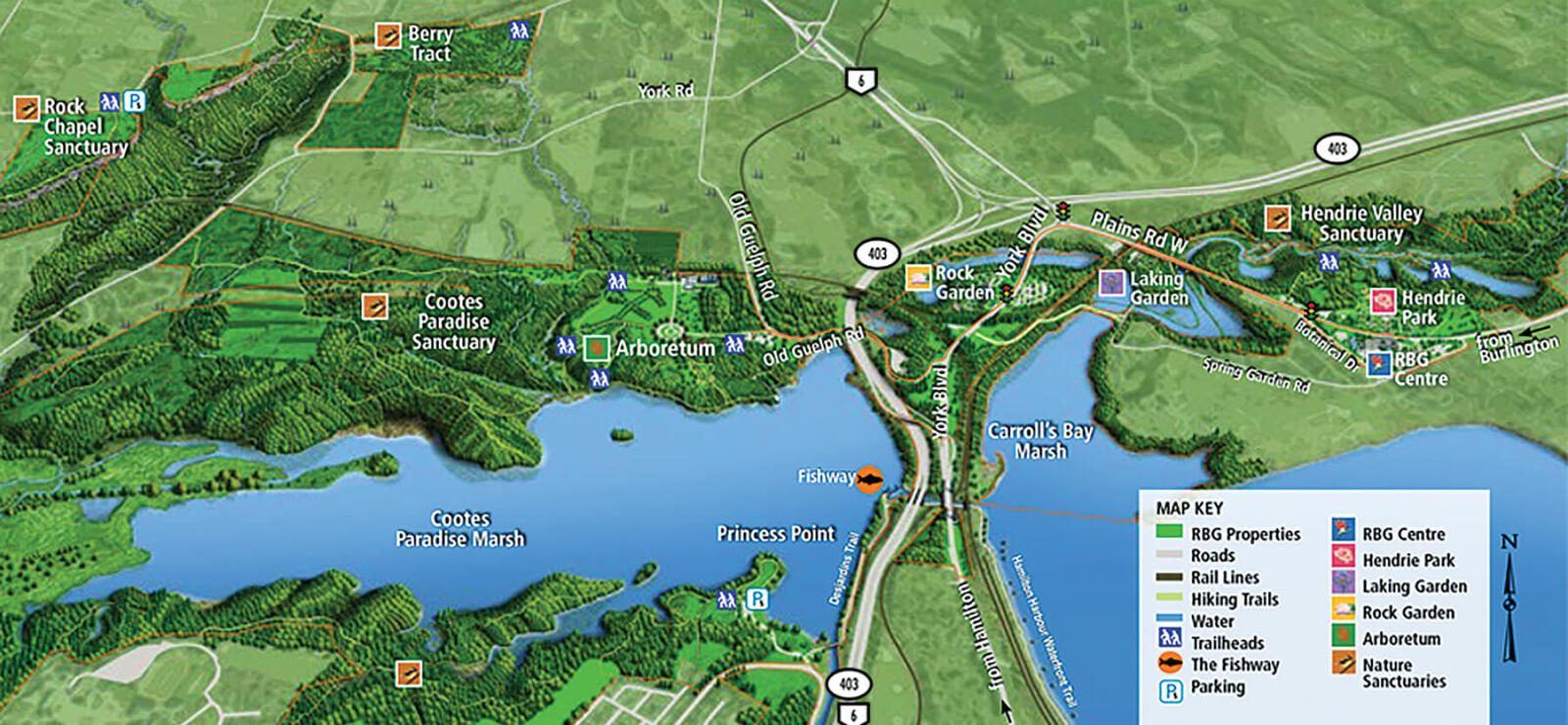January 4, 2020

The 2,700 acre Royal Botanical Gardens is home to 20 per cent of Canada’s wild plants.
Royal Botanical Gardens reveals long-term master plan design concept
Royal Botanical Gardens (RBG) together with primary consultant MT Planners, shared new details of its 25-year master planning initiative as part of the Seeding our Future Public Open House, held Nov. 21.
As a core environmental system within the fastest growing region in Canada, RBG’s 2,700 acres of environmentally sensitive areas (including nature sanctuaries, cultivated gardens and an arboretum), make up the last ecological corridor between Lake Ontario and the Niagara Escarpment and contain biologically diverse Carolinian Forest that is home to the highest concentration of wild plants in the country — 20 per cent of Canada’s wild plant population — as well as 58 species-at-risk. These areas are threatened with potentially devastating habitat loss stemming from environmental factors that include climate change and urbanization.
“While RBG serves as a significant tourist and cultural destination, and the need to achieve financial sustainability is clear, our intrinsic value is to affect real and positive change in how humanity interacts with our environment,” said CEO Mark Runciman. “We have pledged to take full advantage of our resources, knowledge and reputation in order to achieve our vision.”
The plan will define RBG’s diverse geographic impact as:
A “new” Royal Botanical Gardens would connect its diverse properties to create a unique set of destinations and new experiences that connect visitors to its our green spaces. RBG revealed very early design concepts of several potential long-term projects aimed to transform the gardens into a world-leading tourist, conservation and environmental education destination.
“The opportunity to transform, not only RBG, but make significant positive change in our community, region and beyond is truly inspiring,” said Runciman. “To make these ambitious goals a reality, RBG will be launching a major capital fundraising campaign. The implementation of the plan will involve input from all stakeholders in determining the future direction of RBG and deepen partnerships with municipalities, conservation authorities, commissions, and other provincial institutions.”
The completed plan will identify short-term capital projects to be addressed in the next five years, as well as the longer-term projects for the next 25 years, while imagining RBG’s role as an environmental steward for several generations. The plan will be completed at the end of February 2020 and approved by RBG’s board of directors in mid-March 2020.
As a core environmental system within the fastest growing region in Canada, RBG’s 2,700 acres of environmentally sensitive areas (including nature sanctuaries, cultivated gardens and an arboretum), make up the last ecological corridor between Lake Ontario and the Niagara Escarpment and contain biologically diverse Carolinian Forest that is home to the highest concentration of wild plants in the country — 20 per cent of Canada’s wild plant population — as well as 58 species-at-risk. These areas are threatened with potentially devastating habitat loss stemming from environmental factors that include climate change and urbanization.
“While RBG serves as a significant tourist and cultural destination, and the need to achieve financial sustainability is clear, our intrinsic value is to affect real and positive change in how humanity interacts with our environment,” said CEO Mark Runciman. “We have pledged to take full advantage of our resources, knowledge and reputation in order to achieve our vision.”
The plan will define RBG’s diverse geographic impact as:
- A community hub and daily centre for immersion and refuge in nature, educating the local community to develop daily practices that benefit the health of people and local ecologies.
- A regional resource and tool for action and partnerships to protect and enhance natural systems.
- A provincial partner with institutions, agencies, organizations and businesses to create collaborative offerings, attractions and educational programming for Ontarians and tourists.
- A national laboratory for ecological research.
- A global citizen that provides science-based input to drive global initiatives for a better future for our planet.
A “new” Royal Botanical Gardens would connect its diverse properties to create a unique set of destinations and new experiences that connect visitors to its our green spaces. RBG revealed very early design concepts of several potential long-term projects aimed to transform the gardens into a world-leading tourist, conservation and environmental education destination.
“The opportunity to transform, not only RBG, but make significant positive change in our community, region and beyond is truly inspiring,” said Runciman. “To make these ambitious goals a reality, RBG will be launching a major capital fundraising campaign. The implementation of the plan will involve input from all stakeholders in determining the future direction of RBG and deepen partnerships with municipalities, conservation authorities, commissions, and other provincial institutions.”
The completed plan will identify short-term capital projects to be addressed in the next five years, as well as the longer-term projects for the next 25 years, while imagining RBG’s role as an environmental steward for several generations. The plan will be completed at the end of February 2020 and approved by RBG’s board of directors in mid-March 2020.